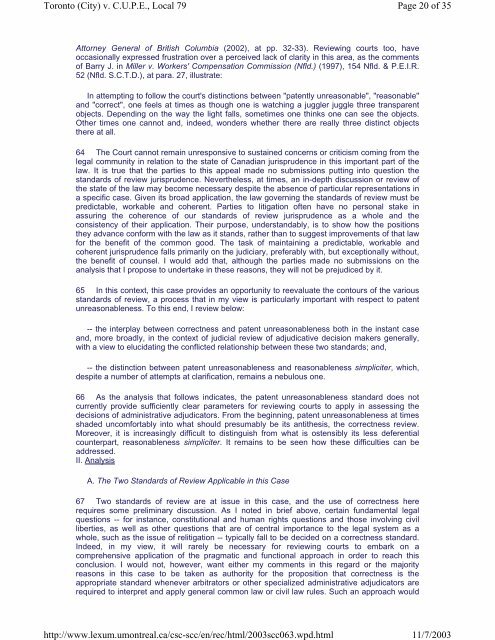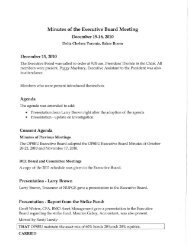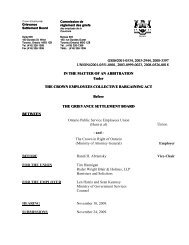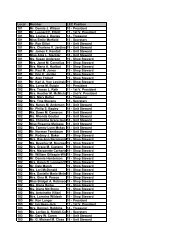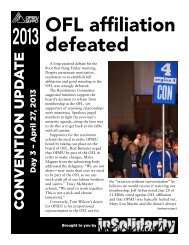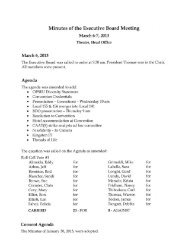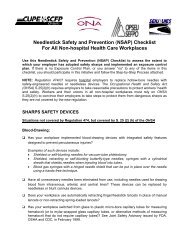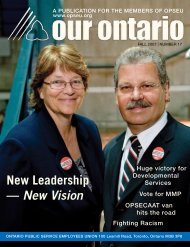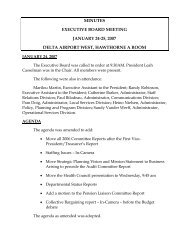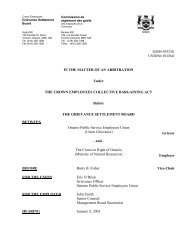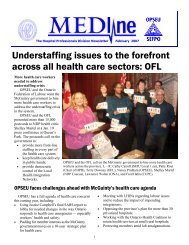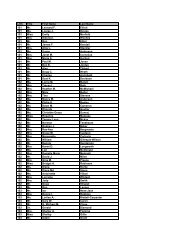C.U.P.E., Local 79 v. Toronto (City) .pdf - OPSEU
C.U.P.E., Local 79 v. Toronto (City) .pdf - OPSEU
C.U.P.E., Local 79 v. Toronto (City) .pdf - OPSEU
Create successful ePaper yourself
Turn your PDF publications into a flip-book with our unique Google optimized e-Paper software.
<strong>Toronto</strong> (<strong>City</strong>) v. C.U.P.E., <strong>Local</strong> <strong>79</strong><br />
http://www.lexum.umontreal.ca/csc-scc/en/rec/html/2003scc063.wpd.html<br />
Page 20 of 35<br />
11/7/2003<br />
Attorney General of British Columbia (2002), at pp. 32-33). Reviewing courts too, have<br />
occasionally expressed frustration over a perceived lack of clarity in this area, as the comments<br />
of Barry J. in Miller v. Workers' Compensation Commission (Nfld.) (1997), 154 Nfld. & P.E.I.R.<br />
52 (Nfld. S.C.T.D.), at para. 27, illustrate:<br />
In attempting to follow the court's distinctions between "patently unreasonable", "reasonable"<br />
and "correct", one feels at times as though one is watching a juggler juggle three transparent<br />
objects. Depending on the way the light falls, sometimes one thinks one can see the objects.<br />
Other times one cannot and, indeed, wonders whether there are really three distinct objects<br />
there at all.<br />
64 The Court cannot remain unresponsive to sustained concerns or criticism coming from the<br />
legal community in relation to the state of Canadian jurisprudence in this important part of the<br />
law. It is true that the parties to this appeal made no submissions putting into question the<br />
standards of review jurisprudence. Nevertheless, at times, an in-depth discussion or review of<br />
the state of the law may become necessary despite the absence of particular representations in<br />
a specific case. Given its broad application, the law governing the standards of review must be<br />
predictable, workable and coherent. Parties to litigation often have no personal stake in<br />
assuring the coherence of our standards of review jurisprudence as a whole and the<br />
consistency of their application. Their purpose, understandably, is to show how the positions<br />
they advance conform with the law as it stands, rather than to suggest improvements of that law<br />
for the benefit of the common good. The task of maintaining a predictable, workable and<br />
coherent jurisprudence falls primarily on the judiciary, preferably with, but exceptionally without,<br />
the benefit of counsel. I would add that, although the parties made no submissions on the<br />
analysis that I propose to undertake in these reasons, they will not be prejudiced by it.<br />
65 In this context, this case provides an opportunity to reevaluate the contours of the various<br />
standards of review, a process that in my view is particularly important with respect to patent<br />
unreasonableness. To this end, I review below:<br />
-- the interplay between correctness and patent unreasonableness both in the instant case<br />
and, more broadly, in the context of judicial review of adjudicative decision makers generally,<br />
with a view to elucidating the conflicted relationship between these two standards; and,<br />
-- the distinction between patent unreasonableness and reasonableness simpliciter, which,<br />
despite a number of attempts at clarification, remains a nebulous one.<br />
66 As the analysis that follows indicates, the patent unreasonableness standard does not<br />
currently provide sufficiently clear parameters for reviewing courts to apply in assessing the<br />
decisions of administrative adjudicators. From the beginning, patent unreasonableness at times<br />
shaded uncomfortably into what should presumably be its antithesis, the correctness review.<br />
Moreover, it is increasingly difficult to distinguish from what is ostensibly its less deferential<br />
counterpart, reasonableness simpliciter. It remains to be seen how these difficulties can be<br />
addressed.<br />
II. Analysis<br />
A. The Two Standards of Review Applicable in this Case<br />
67 Two standards of review are at issue in this case, and the use of correctness here<br />
requires some preliminary discussion. As I noted in brief above, certain fundamental legal<br />
questions -- for instance, constitutional and human rights questions and those involving civil<br />
liberties, as well as other questions that are of central importance to the legal system as a<br />
whole, such as the issue of relitigation -- typically fall to be decided on a correctness standard.<br />
Indeed, in my view, it will rarely be necessary for reviewing courts to embark on a<br />
comprehensive application of the pragmatic and functional approach in order to reach this<br />
conclusion. I would not, however, want either my comments in this regard or the majority<br />
reasons in this case to be taken as authority for the proposition that correctness is the<br />
appropriate standard whenever arbitrators or other specialized administrative adjudicators are<br />
required to interpret and apply general common law or civil law rules. Such an approach would


